Leipzig was in a way my most important destination on the Grand Tour, not least because it was the place where Johann Sebastian Bach spent the last 27 years of his life, writing the St Matthew Passion, the B Minor Mass, the Christmas Oratorio, the Goldberg Variations, more than 250 cantatas, and many other works.
There was plenty of other musical interest too. JS Bach's youngest son Johann Christian, 'the English Bach', was born here in 1735. Felix Mendelssohn – who was largely responsible for the revival of public interest in Bach's music, 80 years after his death – lived here and was conductor of the Leipzig Gewandhaus Orchestra for 12 years from 1835. Robert Schumann initially studied law in Leipzig, took piano lessons here from Clara Wieck's father, married Clara in 1840, and taught composition at Liepzig Conservertoire. Richard Wagner was born here in 1813, and Gustav Mahler was second conductor of the Leipzig Opera in 1886/7... / more
For a good choice of hotels with discount prices, visit Where to stay in Leipzig for more information. |
Thomaskirche
From the tram stop in Augustusplatz I slowly walked the short distance into the city centre; there was a really nice feel to the place as I passed the new building work in Grimmaische Straße, and the Altes Rathaus... And there in front of me was the Thomaskirche, possibly the main focus for this whole trip, the place where J S Bach was cantor for 27 years and wrote so much. I took a few photos of his statue outside the church. And finally inside, where I stayed for 80 minutes just absorbing it all, and trying to take some photos to convey the atmosphere...
• Click for photos and more |
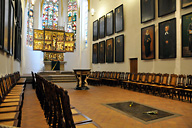 |
Nikolaikirche
Then to the Nikolaikirche, with its remarkable, late 18th century, white and pink and pastel green leafy interior. The church was the rallying point for protestors during the Wende, the peaceful revolution that led to the end of Communist rule, and ultimately to German reunification. Photos of the sombre mediaeval exterior are hopeless, with the church being hemmed in by other buildings. A small bust of Johann Sebastian Bach just inside the west entrance...
• Click for photos and more |
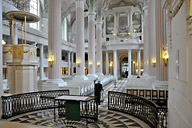 |
Mendelssohn-Haus
The flat on the first floor of the Mendelssohn-Haus is where Felix Mendelssohn lived for the last two years of his life. He and his family moved here in 1845, and their music salon was a meeting-place for friends such as Clara Schumann, Liszt, Berlioz, Gade, Joachim and Moscheles, all of whom walked on the inlaid wooden floors that remain in the flat today. It has been beautifully restored, with some of his original furniture, and much care taken to add appropriate things. Plain pastel walls have the simplest of decoration. His study recreated as it was, based on a contemporary watercolour...
• Click for photos and more |
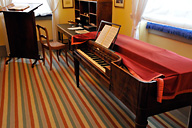 |
Gewandhaus
Stopping off at Augustusplatz – the huge open square just east of the city centre – on my way into town, I found myself in front of the Gewandhaus, home of the Leipzig Gewandhaus Orchestra that I've heard so many times on disc. The present avant-garde Gewandhaus [Textile Hall] is the third building to bear the name, and was opened in 1981, exactly 200 years after a group of musicians formed in 1743 under the name Grosses Concert moved into a renovated textile hall in 1781; it is arguably the oldest orchestra still performing, other than those of the royal courts...
• Click for photos and more |
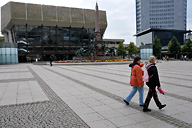 |
Opera House
Facing the Gewandhaus across the great open space of Augustusplatz is the sombre building of the Opera House. It opened in 1960 on the site of the New Theatre, which had been destroyed during WWII. The Leipzig Opera was founded in 1693 as the third public opera house in Europe, and since 1840 the Leipzig Gewandhaus Orchestra has been the house orchestra for productions by Leipzig Opera and the Leipzig Ballet.
• Click for photos and more |
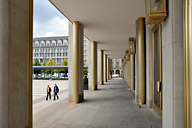 |
Altes Rathaus [old town hall]
The main attraction in the 1557 Altes Rathaus, which dominates the Markt, is the 53-metre long Festsaal [Banqueting Hall]. Under a decorated beamed ceiling, three walls are lined with portraits of Leipzig magistrates and large paintings of Saxon regents, punctuated by three large Baroque fireplaces. Near the entrance is a 5m x 5m scale model of Leipzig dating from 1823. In a side room is the painting of J S Bach by Elias Gottlob Haussman, thought to be the only likeness of him painted in his lifetime...
• Click for photos and more |
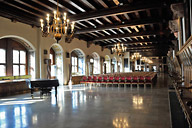 |
Hauptbahnhof
Leipzig's main station is huge, the largest terminal station in Europe. Its facade is 293m wide, and the early 20th century design has been well restored after neglect in the communist years. Originally it was operated by two different railway companies, so there are two imposing entrances. Outside photos were difficult due to the size of the building and the traffic on the ring road. Inside I found an old steam engine – a 2-10-0 with a bogie tender – and rolling stock, parked at one of the platforms...
• Click for photos and more |
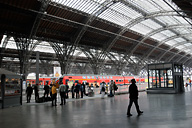 |
In the City
There are many attractive buildings in Leipzig, in addition to my specific hightlights. One that's unmissable is the Jugendstil Speck's Hof shopping mall. And I liked the Alte Handelsbörse [Old Exchange], which was built in the 17th century in the early baroque style as a place where merchants could meet. Today it is often used for events such as chamber music and literary gatherings, scientific lectures, receptions and conferences. In front of it stands a statue of Goethe.
• Click for photos and more |
 |
Arrival: Arriving at the Hauptbahnhof dead on time, I headed straight across Willy-Brandt-Platz to Tourist Information. Strangely I didn't see any signs to it in the station, and I don't think I would have found it easily if I hadn't done my homework. I bought a 3-day Leipzig card – now €18.50, not the €11.50 reported from three or four years ago in the Rough Guide – and picked up a city map and a transport map; stupidly the city map doesn't also show the tram routes, as the good ones usually do (the Vienna map, and my RG map of Prague for example) so you have to consult both.
Thoughts on Leipzig as I moved on to Weimar: I really liked it, even more than I thought I would, the modern parts as well as the old. Not disappointed in any way by the Thomaskirche; the Nikolaikirche is also superb. Transport is good, hotel good, restaurant good, and I found a nice traditional tea shop. A friendly feel to the city. My only regret is missing the Schumann museum. Building work makes it awkward for photography, but it's well up there with Salzburg in my list of places to come back to. |
|
|